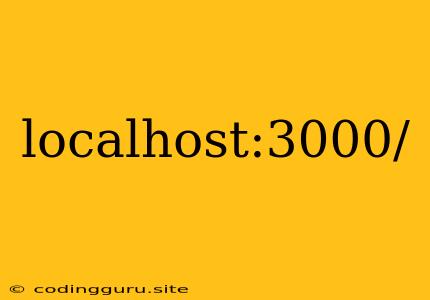Understanding localhost:3000 - Your Gateway to Local Development
You've probably encountered the mysterious localhost:3000 while navigating the world of web development. It seems like an address, but what exactly does it signify?
Think of localhost:3000 as the address your web browser uses to communicate with your running web application on your own computer. Let's break it down further:
- localhost: This word refers to your local machine. It's a special name that always points to your own computer, regardless of its actual IP address.
- : This colon separates the hostname (
localhost) from the port number. - 3000: This is the default port used by many web development frameworks, including React, Next.js, and Node.js. It's like a specific channel your application listens for requests on.
Why is localhost:3000 so important?
It's your sandbox for testing your web applications before deploying them to the real world. Here's why:
- No need for a live server: You can develop and experiment with your code without relying on a public web server.
- Instant feedback: As you modify your code, the changes are reflected in your browser instantly, allowing for rapid prototyping and testing.
- Safety:
localhostis a private network, ensuring that your code isn't accessible to others unless you explicitly configure it.
When do you see localhost:3000?
You'll typically see localhost:3000 in the following scenarios:
- Starting your development server: When you run a development server with a web development framework like React or Next.js, the server starts listening on
localhost:3000by default. - Opening your project in a browser: After starting the development server, you open your web application in your browser by typing
localhost:3000in the address bar.
What if I see a different port number?
Some frameworks might use a different port number. For example, you might see localhost:3001 or localhost:5000. This is usually configurable, and you can change it in your project's settings.
What about localhost without a port number?
localhost alone generally refers to your machine's default web server, which usually listens on port 80. However, in web development, you'll often see localhost:3000 because it's specifically associated with development servers.
Can I change the default port?
Absolutely! Most frameworks let you change the port by specifying a different value when starting the server. For example:
- React: You can change the port using the
--portflag:npm start --port 5000 - Next.js: Similar to React, you can modify the port using the
--portflag:next dev --port 5000
Understanding localhost:3000 is crucial for any aspiring web developer. It's your gateway to building and refining your web applications in a safe and controlled environment. Feel free to experiment with your code, change ports, and watch your applications come to life on your own machine!
